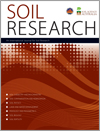An editorial to celebrate the 60th anniversary of the Soil Research journal.

Soil Research
Volume 60 Number 8 2022
This regional study evaluated the effect of irrigation on soil physical properties in the topsoil and subsoil, under pastoral grazing and sprinkler irrigation. Under irrigation there was a shift towards a greater abundance of smaller pores, reflected in macroporosity (indicating soil compaction) and readily available water capacity being significantly lower under irrigation, than for dryland. For irrigation management, this could mean farmers potentially having to irrigate more frequently or adopting deficit irrigation to minimise soil compaction.
SR21254 Abstract | SR21254 Full Text | SR21254PDF (665 KB) | SR21254Supplementary Material (1.1 MB) Open Access Article
While both physical fractionation (size separation) and chemical extraction (using hot water) are widely used to partition soil organic matter (SOM) into components that differ in lability, the relationship between these two approaches remains unclear. We measured hot water extractable C in particle-size fractions isolated from soil under a diverse set of treatments. All size fractions contributed to hot water extractable C, with the clay fraction (putatively the most stable SOM fraction), being the dominant source.
SR21251 Abstract | SR21251 Full Text | SR21251PDF (1 MB) Open Access Article
SR21094Soil nitrous oxide emissions in a maize (Zea mays L.) crop in response to nitrogen fertilisation
The western region of the Argentine Pampas is a large producer of grain. Fertilisers used are mainly urea and urea–ammonium nitrate. Most of the nitrous oxide emissions – a greenhouse gas with high global warming potential – are linked to nitrogen fertilisation. Total nitrous oxide emissions differed between the applied N rates, but not between the fertiliser types used. This study contributes to a low-carbon agriculture and the prevention of environmental damage.
Our results showed that the change of P fractions in soils under different treatments can be attributed to soil pH and OC concentration that responded to the application of different fertilisers. The sources of soil available P under organic fertilisation were significantly different from those of chemical fertilisation. Our results provide information to effectively utilising different P fractions in soils.
SR21136Impact of litter quality on the stability and storage of soil carbon in flooded wetlands
High inputs of wetland litters and slow decomposition of soil organic carbon (SOC) influence the biogeochemical cycling of soil carbon in flooded wetlands. However, the effects of high- vs low-quality litter inputs on SOC stability and storage in flooded wetlands are largely unclear. Our study suggests that inputs of low-quality litters can lead to more recalcitrant carbons and increase soil carbon stability and carbon sequestration, which is beneficial for flooded wetlands to play the role of carbon sink.
SR21271Optimisation and modelling of draft and rupture width using response surface methodology and artificial neural network for tillage tools
 , Prem Shanker Tiwari, Kamal Nayan Agrawal, Ajay Kumar Roul, Manoj Kumar and Karan Singh
, Prem Shanker Tiwari, Kamal Nayan Agrawal, Ajay Kumar Roul, Manoj Kumar and Karan Singh
Image processing techniques were used for rupture width measurement. Optimisation of minimum draft with maximum rupture width was observed using response surface methodology (RSM). Artificial neural network and RSM models were developed for draft and rupture widths. Developed models performed better than analytical models in predicting the draft and rupture width.
Labile soil carbon and nitrogen are important indicators for evaluating carbon sequestration and nutrient availability under forest management such as thinning. This study assessed the effects of 15% and 30% thinning on labile soil carbon and nitrogen indices. Results showed that both thinning intensities increased labile carbon and nitrogen concentrations and caused nitrogen-limited conditions for microbes by incorporating additional deadwoods to the soil. Our findings highlight the significance of remaining deadwoods in terms of the ecosystem functions in thinned forests.
Excessive chemical application in agriculture causes environmental disorders affecting both soil quality and plant health. Rhizobacteria from Algerian olive rhizosphere (Olea europaea L.) showed plant growth promoting traits, cell wall degrading enzymes production, and acceleration of germination and vegetative development of Phaseolus vulgaris L. and Cucurbita pepo L. The tested rhizobacteria identified as Bacillus cereus and Bacillus thuringiensis offer important properties for sustainable agriculture.
SR21320 Abstract | SR21320 Full Text | SR21320PDF (2.8 MB) Open Access Article



